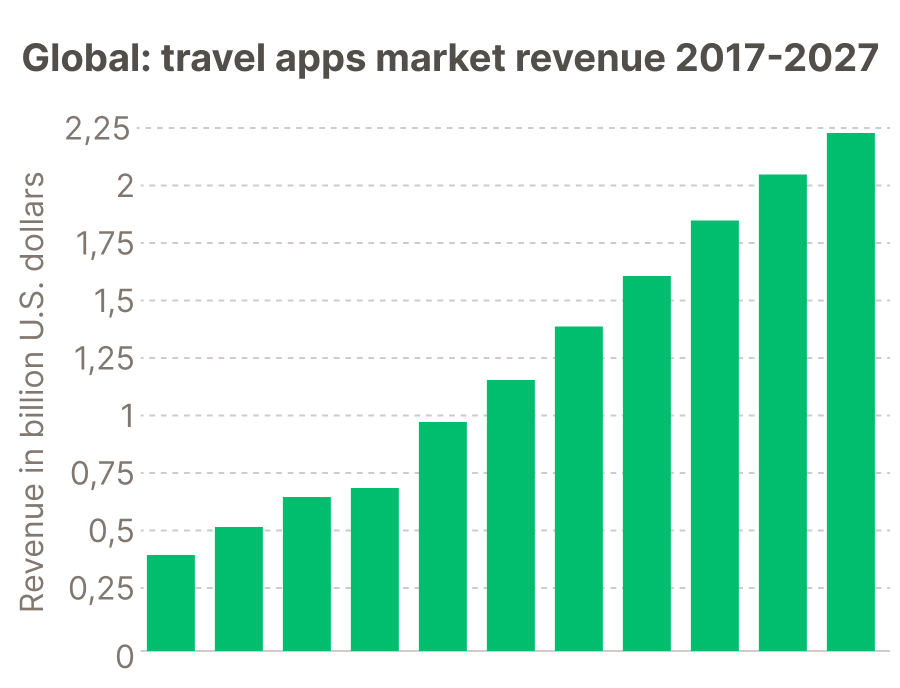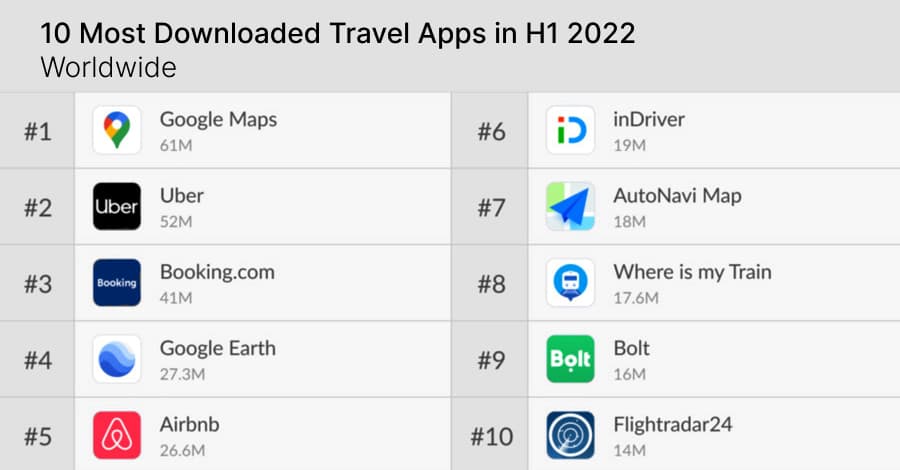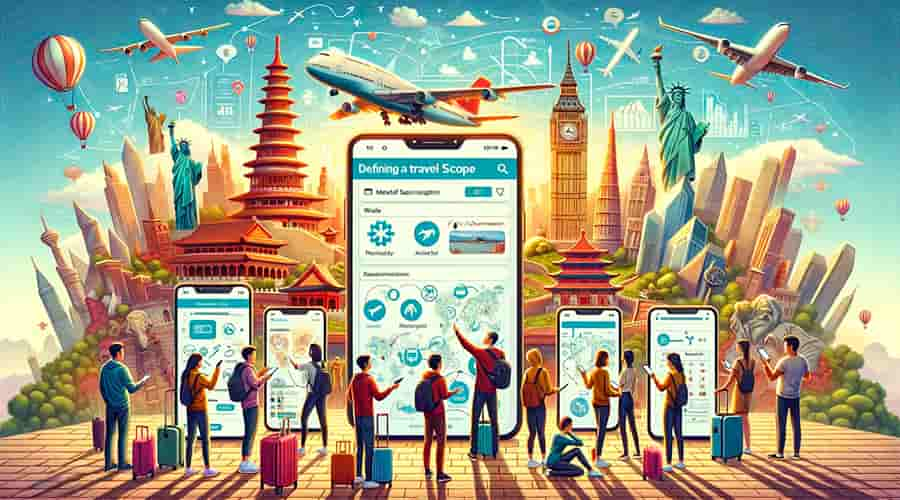Roadmap to Building a Travel App That Stands Out
Topic: Guides

April 4, 2024
The online travel booking industry was one of the hardest hit by the coronavirus pandemic. Travel restrictions, lockdowns, and consumer hesitancy to book trips amidst the health crisis dealt a severe blow, with major players like Booking Holdings, Expedia Group, and Airbnb reporting revenue declines ranging from 55% to 80% in 2020. However, the industry demonstrated resilience and adaptability, managing to recover as vaccination rollouts progressed and travel resumed.
According to Allied Market Research, the global mobile travel booking market size was $228.4 billion in 2021 and is estimated to reach $612.5 billion by 2031, driven by the increasing preference for seamless, on-the-go travel planning experiences. Developing a successful travel app has emerged as a lucrative opportunity for businesses seeking to cater to the needs of modern travelers. This comprehensive guide aims to provide a detailed roadmap for building a user-friendly, feature-rich travel app that resonates with tech-savvy users and stands out in a highly competitive market.
Benefits of Travel Apps
By investing in travel app development, businesses can unlock numerous advantages, including:
- Increased brand visibility and customer reach
- Streamlined booking processes for flights, hotels, and activities
- Enhanced customer engagement and loyalty
- Access to valuable user data for personalization and targeted marketing
- Opportunities for revenue diversification through in-app purchases and partnerships

Defining Your Travel App's Scope
Before embarking on the travel app development process, it's crucial to clearly define the app's scope, target audience, and unique value proposition.
Identifying Target Audience for Travel App
Conduct market research to understand the demographics, preferences, and pain points of your target users. According to a recent survey by Phocuswright, 48% of travelers prioritize cost when booking trips, while 35% value unique experiences and activities. Additionally, studies show that millennials account for 60% of travel app downloads and usage. So you should ask yourself: Are you catering to budget-conscious backpackers, luxury travelers, or business travelers? Tailoring your app to specific user segments will ensure a more personalized and engaging experience.
Researching Competitor Apps and User Needs
The next step is to analyze existing travel apps in the market to identify gaps, strengths, and areas for improvement. Gather user feedback and reviews to gain insights into desired features, usability issues, and unmet needs. This competitive analysis will inform your app's niche and unique selling points.
Determining Key Features and Functionalities
Based on your target audience and competitive research, define the core features and functionalities your travel app will offer. Consider must-have features for travel apps such as flight and accommodation booking, itinerary planning, activity booking, and personalized recommendations. Prioritize features based on user demand and business objectives.
Designing the Travel App User Experience (UX)
A well-designed user experience is paramount for the success of your travel app. It should prioritize intuitive navigation, seamless information architecture, and personalization options to enhance user satisfaction and engagement.
Intuitive User Interface (UI) Design
Implement travel app UI design best practices, such as consistent visual elements, clear typography, and intuitive iconography. Ensure a visually appealing and uncluttered interface that aligns with your brand identity while adhering to platform-specific design guidelines (e.g., iOS Human Interface Guidelines, Material Design for Android). For example, popular travel apps like Airbnb and TripAdvisor use clean, minimalist designs with bold imagery and clear call-to-action buttons.
User-Friendly Travel App Navigation
Design a logical and user-friendly travel app navigation structure that allows users to access desired information and functionalities with minimal effort. Implement effective information architecture principles, such as categorization, labeling, and search functionalities, to enhance discoverability and usability. For instance, Booking.com uses a straightforward navigation menu with categories like "Stays," "Flights," "Car Rentals," and "Attractions," making it easy for users to find what they need.
Personalization and Customization Options
Incorporate personalization features that adapt to users' preferences, travel histories, and behavior patterns. Allow users to customize their profiles, save preferences, and receive tailored recommendations for destinations, activities, and accommodations based on their unique interests and travel styles. Leveraging machine learning algorithms, apps like TripAdvisor and Google Trips can suggest personalized itineraries and recommendations based on the user's previous searches, bookings, and reviews.
Implement Consistent Branding and Visual Design
Ensure that your travel app's visual design is consistent with your brand's identity, including color schemes, typography, and iconography. This consistency helps reinforce brand recognition and creates a cohesive user experience across all touchpoints. For example, Airbnb's distinctive use of the "Bélo" typeface and its iconic logo creates a recognizable and memorable brand experience within the app.
Prioritize Travel App Accessibility and Inclusivity
Design your travel app with accessibility and inclusivity in mind, ensuring that users with disabilities or diverse needs can easily navigate and interact with the app. Follow travel app accessibility guidelines, such as providing alternative text for images, supporting screen readers, and offering adjustable font sizes and color contrasts. Apps like Uber and Lyft have implemented features like wheelchair-accessible vehicle options and VoiceOver compatibility to cater to users with diverse needs.
Conduct Mobile App Usability Testing and Iterate
Regularly conduct usability testing with a diverse group of users to identify any pain points, usability issues, or areas for improvement in the app's design and functionality. Iterate and refine the user experience based on valuable user feedback and usage data. Continuous testing and iteration are crucial for ensuring that your travel app remains user-friendly and meets evolving user expectations.
By prioritizing intuitive UI design, seamless navigation, personalization, consistent branding, accessibility, and continuous usability testing, you can create a compelling and engaging user experience that sets your travel app apart from competitors.

Incorporating Must-Have Features of Travel Apps
While the specific features will depend on your travel app's niche and target audience, several essential functionalities should be considered for a comprehensive travel app experience.
Tourist Destination Discovery
Implement robust search and filtering capabilities that allow users to explore and discover destinations based on various criteria, such as location, budget, interests, and travel dates. Integrate high-quality visuals, detailed descriptions, and user-generated content (e.g., reviews, ratings) to aid decision-making.
Accommodation Booking (Hotels, Hostels, Airbnb, Vacation Rentals)
Integrate seamless booking functionalities for a wide range of accommodation options, including hotels, hostels, vacation rentals, and Airbnb listings. Provide detailed property information, amenities, pricing, and availability to streamline the booking process. These are essential hotel booking app features that users expect.
Transportation Booking (Flights, Trains, Buses, Car Rentals)
Facilitate transportation booking by integrating with third-party APIs or partnering with travel providers. Allow users to search, compare, and book flights, trains, buses, and car rentals within the app, offering a one-stop-shop experience. These are crucial flight booking app functionalities for a well-rounded travel app.
Itinerary Planning and Scheduling
Empower users to create personalized itineraries by enabling them to add and organize accommodations, transportation, activities, and points of interest. Offer smart scheduling features that optimize itineraries based on location, travel dates, and user preferences. Robust travel itinerary management features can significantly enhance the user experience.
Activities and Experiences (Tours, Sightseeing, Dining, Entertainment)
Curate a comprehensive database of local activities, tours, sightseeing opportunities, dining options, and entertainment venues. Integrate booking functionalities and provide detailed information, reviews, and ratings to help users make informed decisions. These activity booking app functionalities are essential for a well-rounded travel app experience.
By incorporating these essential travel booking app features, including flight booking app functionalities, hotel booking app features, activity booking app functionalities, and travel itinerary management features, you can create a comprehensive and user-friendly travel app that meets the diverse needs of modern travelers.
Enhancing the Travel App with Advanced Functionalities
To elevate the user experience and stay ahead of the competition, consider incorporating advanced functionalities that leverage emerging technologies and address user needs.
Travel App Push Notifications for Updates and Reminders
Implement a robust push notification strategy to keep users informed about flight updates, booking confirmations, itinerary changes, and personalized recommendations. Ensure notifications are timely, relevant, and context-aware to avoid user fatigue.
Integrating Mapping and Navigation Tools
Leverage location-based services and mapping APIs (e.g., Google Maps, Apple Maps) to provide turn-by-turn navigation, real-time traffic updates, and location-based recommendations for nearby attractions, restaurants, and services.
Incorporating Cloud Computing for Travel App Scalability and Flexibility
Adopt cloud-based solutions to ensure your travel app can scale seamlessly to accommodate varying user loads and data storage requirements. Cloud computing also enables real-time data synchronization across devices and facilitates seamless integration with third-party services.

Adopting an Agile Development Approach
To keep pace with evolving user needs and market trends, embrace an agile development methodology for your travel app.
Iterative Development and Rapid Prototyping
Follow an iterative development cycle, where travel app features are developed and released in incremental stages. What does it mean? Instead of building the entire application in one long development cycle, iterative development breaks down the process into multiple iterations or sprints. Each iteration focuses on delivering a specific set of features or functionalities. This approach allows for continuous feedback, testing, and refinement throughout the development lifecycle.
For example, in the context of a travel app, the first iteration might focus on building the core functionality of searching and browsing destinations. The second iteration could concentrate on implementing the accommodation booking feature, while the third iteration might introduce flight booking capabilities, and so on. Each iteration builds upon the previous one, gradually adding more features and functionalities until the final product is complete.
Rapid prototyping is a technique used within iterative development to quickly create a basic, working model or prototype of the application (or a specific feature) for early validation and user testing. Prototypes are typically low-fidelity or high-fidelity representations of the final product, built with the primary goal of gathering user feedback and identifying potential issues or improvements before investing significant resources in full-scale development.
Incorporating User Feedback and Continuous Improvement
Implement mechanisms for collecting user feedback, such as in-app surveys, rating systems, and analytics tools. Continuously analyze user behavior, feedback, and app performance data to identify areas for improvement and prioritize future updates and feature releases.
Monetizing Your Travel App
While some travel apps offer free services, generating revenue is crucial for long-term sustainability and growth. Explore various monetization strategies to find the right fit for your business model and target audience.
Monetization Strategy | Objective | Considerations |
|---|---|---|
Subscription models for travel apps | Generate recurring revenue streams | - Offer exclusive benefits and premium features - Set appropriate pricing tiers based on value and target - Provide free trial periods to attract new subscribers |
In-app purchase strategies for travel apps | Generate additional revenue streams Offer optional paid features/services | - Implement in-app purchases for upgrades, virtual goods, or ad removal - Partner with relevant travel brands for targeted advertising - Balance ad presence to avoid disrupting user experience |
Partnerships and travel affiliate marketing programs | Earn commissions and referral fees Leverage established travel providers | - Establish partnerships with airlines, hotels, tour operators - Integrate seamless booking within the app - Promote partner offerings through personalized recommendations |
Marketing and Promoting Your Travel App
Once your travel app is developed, implementing an effective marketing and promotion strategy is crucial for user acquisition and sustained growth.
App Store Optimization (ASO) for Travel Apps
Optimize your app's visibility in app stores by carefully crafting app titles, descriptions, keywords, and visuals. Leverage App Store Optimization (ASO) techniques to improve search rankings and drive organic downloads.
Social Media and Content Marketing
Use social media platforms and content marketing strategies to build brand awareness, engage with your target audience, and promote your travel app's features and updates. Create valuable and shareable content, such as travel guides, tips, and destination spotlights.
Leveraging Influencer Partnerships
Collaborate with travel influencers, bloggers, and content creators who align with your travel app target audience and brand values. Influencer partnerships can help expand your reach, build trust, and drive user acquisition through authentic endorsements and sponsored content.
Future Trends and Opportunities in the Travel App Market
As technology continues to evolve, the travel app market will likely see further advancements in areas such as artificial intelligence, virtual and augmented reality, biometric authentication, and the integration of Internet of Things (IoT) devices. Staying ahead of these travel tech trends and adapting to changing user preferences will be crucial for maintaining a competitive edge in the dynamic travel app landscape.
Furthermore, the increasing focus on sustainability and eco-friendly travel practices may drive the development of "green" travel apps that prioritize carbon footprint reduction, promote eco-tourism, and incentivize environmentally conscious travel choices. Businesses that anticipate and cater to these evolving consumer preferences will be well-positioned to capture a larger share of the lucrative travel app market.
Real-life Example of Successful Travel App Development
BahamaGo, an online travel agency, needed a user-friendly website for booking trips to the Bahamas, covering flights, transfers, hotels, and tours. Specific requirements included offering flights from multiple airlines, hotel rooms from internal systems, transparent pricing calculations, and easy booking processes. Technical challenges included legacy Ruby on Rails code, mainstream technology adoption, and integrating data from various sources.
To address these, Cyfrania developers adopted a test-driven development approach, enhancing existing features without compromising functionality. Key features included personalized hotel views, hotel ads, synchronization with cloud hotel management and airline systems, package pricing, and an admin management area. Additionally, an API was provided for partners.
With continuous improvements and performance monitoring, BahamaGo became a stable platform with expanding functionality since its 2012 launch. Marketed effectively, it gained popularity among travelers to The Bahamas, establishing itself as a well-known booking service.
Key Takeaways for Successful Travel App Development
Building a successful travel app requires a deep understanding of user needs, a well-defined development strategy, meticulous design and feature implementation, and a comprehensive marketing approach. By following best practices in UX design, incorporating essential features, adopting agile development methodologies, and leveraging emerging technologies, businesses can create a valuable and engaging travel app that stands out in a competitive market.
Sources for Further Reading
- Travel App Revenue and Usage Statistics (2024) - an article on Business of Apps
- The U.S. Travel Insights Dashboard - insights from U.S. Travel Association
- Travel App Downloads, Time Spent on Mobile up in 2023 - an article on PhocusWire
- What are your most used travel apps/websites/resources? - a discussion on Reddit
- How to build a super app for travel - a video on App Promotion Summit